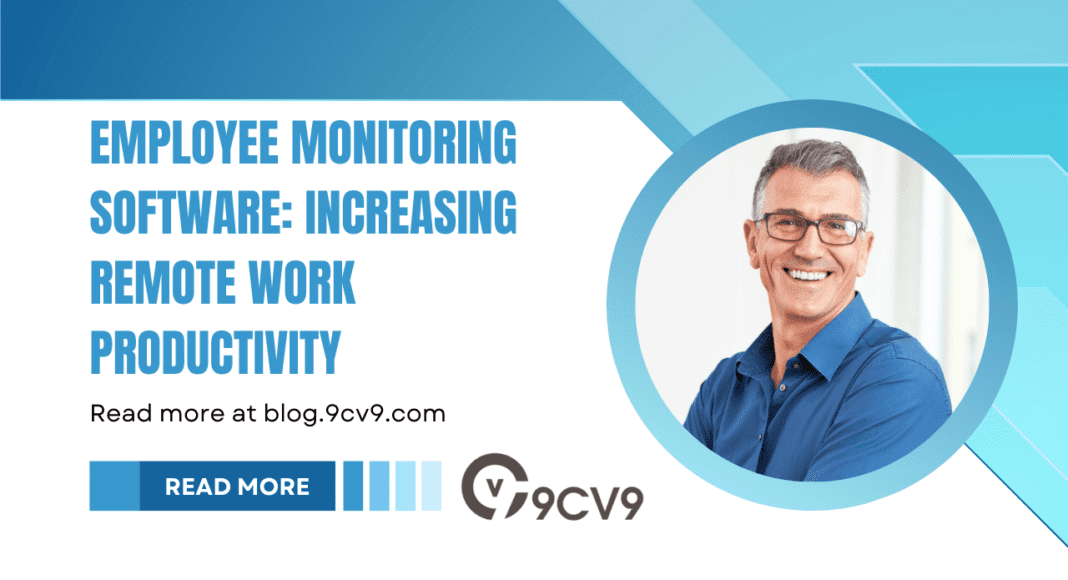Key Takeaways
- Boost Remote Productivity: Employee Monitoring Software offers data-driven insights to optimize remote work efficiency, helping teams achieve their goals from anywhere.
- Balancing Accountability and Trust: Implementing monitoring tools thoughtfully fosters a culture of transparency and empowerment, bridging productivity and employee well-being.
- Navigating the Future: Embrace the synergy of technology and collaboration in the evolving landscape of remote work, guided by Employee Monitoring Software for enhanced productivity.
In an era where the world’s workforce has transcended the traditional confines of office walls, the dynamic landscape of remote work has brought forth an array of opportunities and challenges.
As the sun rises in one corner of the globe, professionals from all walks of life awaken to the soft glow of their laptops, poised to navigate the digital highways of the remote work realm.
The daily commute has transformed into a virtual journey through cyberspace, with home offices and kitchen tables replacing cubicles and corner offices.
Amidst this revolutionary transformation, the pursuit of productivity remains an unwavering beacon for employers and employees alike.
The question that echoes across virtual boardrooms and email threads is a resounding one: How can productivity be upheld and even amplified in an environment where the boundaries between work and personal life blur?
Enter the realm of “Employee Monitoring Software,” a digital ally that stands ready to help navigate the labyrinth of remote work productivity.
Like a compass guiding explorers through uncharted territories, this innovative technology promises to enhance productivity, cultivate accountability, and forge new paths to success in the remote work landscape.
Remote work, once a mere contingency plan, has solidified its position as a cornerstone of modern employment.
As the digital age unfurls its wings, organizations have recognized the benefits of a dispersed workforce – from widening the talent pool to minimizing overhead costs.
Yet, as the allure of flexible schedules beckons, it brings with it a set of unique challenges.
The absence of physical proximity poses a puzzle to managers who yearn for the once-familiar hum of an active office.
Communication barriers, time zone differences, and the elusive work-life balance dance in the shadows, demanding innovative solutions.
Remote workers, in turn, find themselves grappling with isolation, distractions, and the eternal question of when to ‘log off.’
In this tug-of-war between challenges and triumphs, the quest to maintain or elevate productivity becomes paramount. And this is where the digital sentinel, the Employee Monitoring Software, strides onto the scene.
Imagine a symphony where the conductor orchestrates every note to create harmonious melodies.
Similarly, employee monitoring software orchestrates a synchronized work environment, ensuring that the individual notes of tasks, deadlines, and collaboration align to create a productivity symphony.
At its core, employee monitoring software is an ensemble of tools designed to track, analyze, and optimize work-related activities in the digital realm.
This software, once considered a watchful eye, has evolved into a strategic partner in the pursuit of remote work productivity.
From tracking work hours and task completion to providing real-time insights into project progress, this digital companion transcends mere observation.
The canvas of remote work, though digital, is no less intricate than a Renaissance masterpiece.
And much like an artist employing an array of brushes, colors, and techniques, organizations deploy employee monitoring software as their toolkit for enhancing productivity.
By instilling a sense of accountability, monitoring software shapes a culture of ownership among remote employees.
The once-distant concept of ‘teamwork’ is reimagined through shared dashboards, where progress is quantifiable and collaboration tangible.
In the world of remote work, where “out of sight” can sometimes translate to “out of mind,” these digital tools serve as a reminder that every keystroke contributes to the greater mosaic.
As the winds of change continue to reshape the landscape of work, navigating these uncharted waters necessitates not only the right tools but also a skilled navigator.
The effective implementation of employee monitoring software requires a delicate balance between transparency and trust.
Communication becomes the compass guiding organizations, ensuring that the adoption of this technology is not seen as surveillance, but rather as a strategy for fostering productivity and growth.
In this grand saga of work’s evolution, the symphony of remote productivity and employee monitoring software resonates as a testament to adaptation and innovation.
Through data-driven insights and collaborative digital landscapes, organizations redefine the very essence of ‘workplace.’
Embark with us on a digital odyssey, where employee monitoring software is more than mere code; it’s a bridge between the tangible and the virtual.
In the chapters that follow, we delve into the intricacies of this technology – its features, benefits, and the strategies that transform it from an instrument of oversight to an anthem of empowerment.
Join us as we traverse the remote work realm, guided by the luminous glow of productivity and the transformative potential of employee monitoring software.
Before we venture further into this article, we like to share who we are and what we do.
About 9cv9
9cv9 is a business tech startup based in Singapore and Asia, with a strong presence all over the world.
With over six years of startup and business experience, and being highly involved in connecting with thousands of companies and startups, the 9cv9 team has listed some important learning points in this overview of the guide on the Employee Monitoring Software and how using it can increase Remote Work Productivity
If your company needs recruitment and headhunting services to hire top-quality employees, you can use 9cv9 headhunting and recruitment services to hire top talents and candidates. Find out more here, or send over an email to [email protected].
Or just post 1 free job posting here at 9cv9 Hiring Portal in under 10 minutes.
Employee Monitoring Software: Increasing Remote Work Productivity
- The Remote Work Landscape: Challenges and Opportunities
- Understanding Employee Monitoring Software
- Benefits of Employee Monitoring Software for Remote Productivity
- Strategies for Implementing Monitoring Software Effectively
- Balancing Productivity and Trust
1. The Remote Work Landscape: Challenges and Opportunities
In a world propelled by technological advancements and global connectivity, the landscape of work has undergone a metamorphosis, ushering in the era of remote work.
While this shift brings forth a myriad of opportunities, it also presents a tapestry of challenges that organizations and employees must navigate.
Let’s delve into the intricacies of this evolving remote work landscape, exploring its challenges and the opportunities it holds.
1.1 The Rise of Remote Work: An Unprecedented Paradigm Shift
The remote work phenomenon has surged in recent years, accelerated by advancements in digital communication, collaboration tools, and a global pandemic that reshaped traditional work structures.
According to a survey by FlexJobs, remote work experienced a growth of 159% from 2005 to 2021, with 4.7 million people working remotely in the United States alone.
1.2 Challenges Faced by Remote Workers
1.2.1 Isolation and Loneliness
The virtual realm can often feel isolating, with employees missing the camaraderie and informal interactions that occur in physical office spaces. A survey found that 20% of remote workers cited loneliness as their biggest struggle.
1.2.2 Distractions and Work-Life Boundaries
The blurring of work and personal life can lead to a lack of work-life balance, hampering productivity. A survey has indicated that 53.1% of remote workers found it challenging to separate work from personal life.
1.2.3 Communication Barriers
Effective communication can be hindered by the absence of face-to-face interactions. Misinterpretation of messages, delayed responses, and lack of non-verbal cues can impact collaboration. A survey revealed that 20% of remote workers struggled with communication.
1.3 The Opportunities of Remote Work
1.3.1 Access to a Global Talent Pool
Remote work transcends geographical boundaries, enabling organizations to tap into a diverse talent pool. Companies can source skilled professionals regardless of their physical location, fostering innovation and expertise.
1.3.2 Enhanced Work-Life Balance
The flexibility of remote work allows employees to tailor their schedules to accommodate personal responsibilities. This leads to improved work-life balance, contributing to greater job satisfaction and overall well-being.
1.3.3 Increased Productivity and Focus
Remote work can lead to increased productivity due to reduced commute times and a quieter work environment. A Stanford study reported that remote workers saw a 13% performance improvement, partly attributed to fewer distractions.
1.4 Remote Work Challenges for Employers
1.4.1 Monitoring and Accountability
Managing remote teams can pose challenges in monitoring productivity and accountability. Without a physical presence, tracking progress and ensuring tasks are completed on time can be complex.
1.4.2 Employee Engagement and Connection
Maintaining a sense of belonging and engagement among remote employees can be a struggle. Organizations must work diligently to create virtual spaces for social interactions and team bonding.
1.4.3 Leadership and Communication
Remote leadership requires adaptability in communication styles. Regular check-ins, transparent communication, and fostering a culture of trust become vital to ensure remote teams stay aligned.
1.5 Embracing Remote Work: Strategies and Solutions
1.5.1 Virtual Team-Building Initiatives
Companies are implementing virtual team-building activities to foster connections and alleviate isolation. Virtual happy hours, online games, and collaborative projects create a sense of community.
1.5.2 Agile Communication Tools
Organizations are leveraging communication tools such as Slack, Microsoft Teams, and Zoom to bridge the gap between remote team members. These tools enable real-time interactions and seamless collaboration.
1.5.3 Results-Oriented Performance Metrics
Shifting the focus from monitoring hours worked to measuring outcomes can empower remote employees. Clear performance metrics align individual contributions with organizational goals.
As we traverse the remote work landscape, it’s evident that while challenges persist, opportunities abound. Organizations that harness the power of technology, implement thoughtful strategies, and prioritize the well-being of their remote workforce can navigate this landscape with resilience and innovation.
2. Understanding Employee Monitoring Software
In the quest for maximizing remote work productivity, organizations are increasingly turning to innovative solutions such as Employee Monitoring Software.
This section delves into the core concepts of Employee Monitoring Software, shedding light on its functionalities, benefits, and considerations.
2.1 Decoding Employee Monitoring Software: A Comprehensive Overview
Employee Monitoring Software is a technology-driven tool designed to provide insights into various aspects of remote work activities. From tracking time and tasks to monitoring application usage and online behavior, this software offers a panoramic view of an employee’s digital interactions in a work environment.
2.2 Features and Functionalities
2.2.1 Time Tracking and Productivity Analysis
Employee Monitoring Software captures the time spent on tasks, applications, and projects, offering a detailed breakdown of how employees allocate their working hours.
2.2.2 Application and Website Usage Monitoring
By tracking the applications and websites accessed during work hours, this software helps organizations identify patterns of productivity or distractions.
2.2.3 Screenshots and Activity Monitoring
Some software captures screenshots at intervals, allowing managers to visually track an employee’s activities. Additionally, real-time activity monitoring provides insights into active and idle times.
2.3 Benefits of Employee Monitoring Software
2.3.1 Enhanced Productivity and Accountability
Employee Monitoring Software fosters accountability among remote employees. The data-driven insights enable employees to self-assess their productivity and make informed improvements.
2.3.2 Identification of Bottlenecks
Through detailed analytics, this software aids managers in identifying bottlenecks in processes or projects. This, in turn, empowers teams to optimize workflows for better efficiency.
2.3.3 Employee Development and Training
The data collected by the software can be used to identify areas where employees may need additional training or support, leading to targeted skill development.
2.4 Ethical Considerations and Privacy
2.4.1 Balancing Productivity and Privacy
While Employee Monitoring Software can boost productivity, organizations must strike a balance between oversight and privacy. Transparent communication and clear policies are crucial to ensure employees feel respected and valued.
2.4.2 Legal and Compliance Aspects
Organizations need to be mindful of legal regulations and compliance standards when implementing monitoring software. Regulations vary by jurisdiction, and adherence to these laws is paramount.
2.5 Examples of Employee Monitoring Software
2.5.1 Toggl Track
Toggl Track is known for its user-friendly interface and comprehensive time-tracking features. It helps users understand how they spend their work hours, aiding in time management and productivity enhancement.
2.5.2 Hubstaff
Hubstaff offers time tracking, activity monitoring, and screenshot capture features. Its project management capabilities facilitate team collaboration and workflow optimization.
2.5.3 Teramind
Teramind provides advanced employee monitoring with features like behavior analytics, keystroke logging, and real-time alerts. It’s designed to enhance security and productivity simultaneously.
2.6 Data-Driven Insights for Remote Work Optimization
By analyzing the data collected through Employee Monitoring Software, organizations can gain valuable insights into productivity trends, identify areas for improvement, and make informed decisions to optimize remote work strategies.
As we delve deeper into the realm of Employee Monitoring Software, it becomes clear that its role transcends mere oversight. It’s a tool that empowers organizations to leverage data for enhanced productivity, accountability, and employee development.
3. Benefits of Employee Monitoring Software for Remote Productivity
In the realm of remote work, where the traditional confines of the office have dissolved into virtual spaces, organizations are seeking innovative solutions to enhance productivity and accountability.
Employee Monitoring Software emerges as a strategic ally, offering a plethora of benefits that resonate with the evolving dynamics of remote work.
3.1 Fostering Accountability and Ownership
3.1.1 Empowering Self-Management
Employee Monitoring Software equips remote workers with the tools to self-manage their tasks and time. The ability to track their activities and measure their progress encourages a sense of ownership over their work.
3.1.2 Metrics-Driven Approach
The transparency provided by monitoring software shifts the focus from subjective evaluations to objective data. Employees can assess their own performance against quantifiable metrics, fostering accountability.
3.2 Data-Driven Insights for Productivity Optimization
3.2.1 Identifying Peak Productivity Hours
Through detailed time tracking, software reveals when employees are most productive. This data empowers them to schedule their most challenging tasks during these peak hours.
3.2.2 Recognizing and Addressing Distractions
The application usage monitoring feature highlights which applications or websites consume significant time. This insight enables employees to identify and mitigate distractions.
3.3 Streamlining Workflow and Collaboration
3.3.1 Enhancing Project Management
Employee Monitoring Software provides visibility into project progress, allowing teams to assess milestones, allocate resources, and make informed decisions.
3.3.2 Real-Time Collaboration Insights
Managers can access real-time data on employee activities, facilitating informed collaboration. This allows for timely interventions or adjustments to project timelines.
3.4 Performance Recognition and Reward
3.4.1 Objective Performance Evaluation
Monitoring software provides an objective basis for performance evaluation, reducing bias and promoting fair recognition and rewards.
3.4.2 Encouraging a Culture of Achievement
Publicly acknowledging employees who consistently demonstrate high productivity levels fosters a culture of healthy competition and motivation.
3.5 Remote Employee Well-being and Support
3.5.1 Preventing Burnout
By tracking work hours and identifying instances of overwork, Employee Monitoring Software aids in preventing burnout among remote employees.
3.5.2 Targeted Support and Training
Identifying areas where employees may struggle allows organizations to offer targeted support, training, and resources to enhance their skills.
3.6 The Holistic Approach: Balancing Oversight and Trust
Employee Monitoring Software, when integrated thoughtfully, cultivates a culture of trust alongside productivity enhancement. Transparent communication about the purpose of the software ensures that employees view it as a tool for empowerment rather than surveillance.
As we navigate the myriad challenges of remote work, Employee Monitoring Software stands as a beacon of data-driven optimization.
By providing tangible insights, fostering accountability, and promoting collaboration, this software empowers organizations to transcend physical boundaries and unlock the full potential of remote productivity.
4. Strategies for Implementing Monitoring Software Effectively
Integrating Employee Monitoring Software into a remote work environment requires careful planning and execution.
This section delves into the strategies that organizations can adopt to implement monitoring software effectively, ensuring a seamless transition while maximizing its benefits.
4.1 Establish Clear Communication and Transparency
4.1.1 Communicate the Purpose
Transparently communicate the purpose of implementing monitoring software to your remote workforce. Emphasize that the goal is to enhance productivity, streamline workflows, and provide actionable insights.
4.1.2 Address Privacy Concerns
Acknowledge employees’ privacy concerns and clarify how monitoring will be conducted, what data will be collected, and how it will be used. Assure them that their data will be handled in compliance with legal and ethical standards.
4.2 Customization for Organizational Needs
4.2.1 Tailor Monitoring Parameters
Customize monitoring parameters to align with the specific needs and goals of your organization. Different teams might require different metrics to assess productivity effectively.
4.2.2 Incorporate Flexibility
Allow for customization at an individual level, giving employees some control over what aspects are monitored. This empowers them to strike a balance between productivity and comfort.
4.3 Training and Onboarding
4.3.1 Offer Comprehensive Training
Provide thorough training to both employees and managers on how to use the monitoring software effectively. Highlight its features, benefits, and how to interpret the data.
4.3.2 Emphasize Data Interpretation
Educate managers on how to interpret the data collected by the software. Understanding the insights provided ensures informed decision-making and effective interventions.
4.4 Set Clear Performance Metrics
4.4.1 Focus on Outcome Metrics
Define clear outcome-based performance metrics that align with your organization’s objectives. This shifts the emphasis from tracking every activity to measuring meaningful results.
4.4.2 Ensure Realistic Goals
Set achievable performance goals that consider the unique challenges of remote work. Overly ambitious targets can lead to stress and burnout.
4.5 Collaboration and Flexibility
4.5.1 Foster Open Dialogue
Encourage open discussions between managers and employees about the monitoring software’s impact. Use feedback to make necessary adjustments and improvements.
4.5.2 Adaptability to Work Styles
Acknowledge that different employees have varying work styles. Ensure that the software accommodates these differences without imposing rigid constraints.
4.6 Data Security and Compliance
4.6.1 Data Encryption and Protection
Prioritize data security by implementing strong encryption protocols to safeguard sensitive information. Assure employees that their data is protected.
4.6.2 Legal and Regulatory Compliance
Adhere to legal regulations and compliance standards related to employee monitoring. This includes informing employees about the data being collected and obtaining necessary consent.
4.7 Measure Impact and Make Continuous Improvements
4.7.1 Analyze Productivity Trends
Regularly analyze productivity trends and performance metrics to assess the impact of the monitoring software. Identify areas of improvement and success stories.
4.7.2 Adapt and Evolve
Continuously adapt the software’s implementation based on feedback and evolving organizational needs. A flexible approach ensures that it remains effective over time.
Implementing Employee Monitoring Software effectively is not just about deploying the technology; it’s about fostering a culture of collaboration, transparency, and continuous improvement.
When approached thoughtfully, monitoring software can be a catalyst for positive change in remote work dynamics.
5. Balancing Productivity and Trust
In the realm of remote work, where the traditional boundaries of the office have dissolved into the digital landscape, striking a delicate balance between productivity and trust becomes paramount.
This section delves into the strategies and considerations that organizations can employ to achieve this equilibrium while integrating Employee Monitoring Software.
5.1 Cultivating a Culture of Trust
5.1.1 Open and Transparent Communication
Foster a culture of trust by maintaining open lines of communication. Clearly communicate the reasons for implementing monitoring software and how it aligns with the organization’s goals.
5.1.2 Emphasize Empowerment
Highlight that the software’s purpose is to empower employees, not micromanage them. When employees perceive the software as a tool for their growth, trust is nurtured.
5.2 Setting Clear Expectations
5.2.1 Define Monitoring Parameters
Clearly define what aspects will be monitored and how the data will be used. Employees should have a clear understanding of what is expected of them in terms of performance.
5.2.2 Establish Guidelines
Create guidelines that outline the ethical use of monitoring software. This reinforces the idea that the software is a mechanism to enhance collaboration and productivity, not to invade privacy.
5.3 Personalized Approaches to Monitoring
5.3.1 Flexibility in Monitoring Intensity
Recognize that different roles and projects may require varying levels of monitoring. Tailor the monitoring intensity to the nature of the work and the preferences of the employees.
5.3.2 Consent and Inclusion
Involve employees in decisions about monitoring parameters. Obtaining their input and consent empowers them and helps strike a balance between oversight and autonomy.
5.4 Focus on Outcomes, Not Just Activities
5.4.1 Emphasize Performance Goals
Shift the focus from tracking every activity to measuring outcomes. Clearly communicate performance goals and how they contribute to the organization’s success.
5.4.2 Promote Flexibility in Approach
Allow employees to choose the methods and tools that best suit their work style as long as the desired outcomes are achieved.
5.5 Data-Driven Insights for Balancing
5.6.1 Employee Feedback Analysis
Regularly analyze employee feedback to understand their sentiments about monitoring software. Adjust the approach based on their input to maintain a balanced work environment.
5.6.2 Performance and Well-being Metrics
Monitor not only productivity metrics but also well-being indicators. This holistic approach ensures that the pursuit of productivity doesn’t come at the expense of employee health and satisfaction.
Striking a harmonious chord between productivity and trust is a dynamic endeavor. By embracing transparent communication, setting clear expectations, and focusing on outcomes, organizations can create an environment where Employee Monitoring Software enhances productivity without compromising trust.
Conclusion
As the digital realm redefines the landscape of work, the symbiotic relationship between technology and productivity becomes ever more profound.
The journey we’ve embarked upon, exploring the intersection of Employee Monitoring Software and remote work productivity, is one of adaptation, innovation, and balance.
We’ve ventured through the challenges and opportunities of the remote work landscape, delved into the intricacies of monitoring software, and unraveled strategies for its effective implementation.
We’ve navigated the delicate equilibrium between productivity and trust, recognizing that in this new era of work, success lies at the convergence of data-driven insights and a foundation of transparency.
The rise of remote work signifies more than just a shift in location; it’s a testament to the boundless possibilities of a digitally connected world.
From the bustling metropolis to the tranquil countryside, professionals from diverse corners of the globe converge in virtual spaces, redefining the meaning of collaboration and productivity.
In this landscape, where the echoes of traditional office chatter have been replaced by the hum of laptops, Employee Monitoring Software emerges as a beacon of clarity, offering insights that illuminate the path to enhanced productivity.
The strategies we’ve explored for implementing monitoring software effectively reflect the ever-evolving nature of work. Flexibility, adaptability, and a holistic approach to well-being are not just buzzwords; they’re the cornerstones of a work culture that transcends physical confines.
As remote work becomes not just a trend, but a way of life, organizations must champion a culture that embraces the opportunities while addressing the challenges.
In the digital symphony of remote work, data plays a melodious role.
Employee Monitoring Software orchestrates the notes of productivity, accountability, and collaboration, conducting a harmonious performance that resonates across teams and time zones.
But amidst the digital crescendo, the thread of trust remains interwoven.
We’ve witnessed that monitoring software is not a means of surveillance but a tool of empowerment when approached thoughtfully and transparently.
As we pen the conclusion of this chapter, the story of remote work continues to unfold. Innovations emerge, challenges evolve, and the concept of work transforms yet again.
The narrative is not static; it’s a continual overture of innovation and adaptation.
Employee Monitoring Software stands as a crucial element in this evolving narrative, offering organizations the tools to optimize productivity, nurture accountability, and propel remote teams toward success.
The virtual horizon stretches far and wide, offering a vista of possibilities that beckon organizations to embrace the uncharted territory of remote work.
As we cast our gaze forward, it’s clear that Employee Monitoring Software is not just a tool but a stepping stone toward tomorrow’s success stories.
By nurturing a culture of trust, balancing productivity with well-being, and harnessing the power of data-driven insights, organizations have the opportunity to navigate this evolving landscape with confidence and grace.
So, as we raise our virtual glasses to the future of work, let us toast to the seamless integration of technology and humanity.
Let us celebrate the marriage of innovation and empathy, for it’s in this union that the symphony of Employee Monitoring Software and remote work productivity finds its crescendo – a harmonious blend of efficiency and authenticity, a melody that resonates across borders and beyond boundaries.
If your company needs HR, hiring, or corporate services, you can use 9cv9 hiring and recruitment services. Book a consultation slot here, or send over an email to [email protected].
If you find this article useful, why not share it with your hiring manager and C-level suite friends and also leave a nice comment below?
We, at the 9cv9 Research Team, strive to bring the latest and most meaningful data, guides, and statistics to your doorstep.
To get access to top-quality guides, click over to 9cv9 Blog.
People Also Ask
What is the best employee monitoring software?
Determining the best employee monitoring software depends on your specific needs. Consider options like Toggl Track for time management, Hubstaff for activity monitoring, and Teramind for advanced analytics. Choose based on features that align with your remote work goals.
What monitoring software do employers use?
Employers often use a variety of monitoring software options tailored to their needs. Popular choices include Hubstaff, Time Doctor, Teramind, and ActivTrak. These tools assist in tracking employee activities, optimizing productivity, and ensuring remote work success.
What is the use of employee monitoring software?
Employee monitoring software tracks and analyzes remote work activities, enhancing productivity and accountability. It helps employers manage tasks, measure performance, and optimize workflows in virtual environments, fostering a transparent and efficient work culture.































![Writing A Good CV [6 Tips To Improve Your CV] 6 Tips To Improve Your CV](https://blog.9cv9.com/wp-content/uploads/2020/06/2020-06-02-2-100x70.png)


